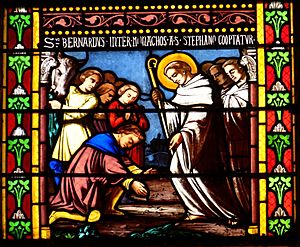Stephen Harding facts for kids
Quick facts for kids SaintStephen Harding O.Cist |
|
|---|---|

Saint Stephen Harding fresco in Apátistvánfalva, Hungary
|
|
| Born | c. 1050 Sherborne, Dorset, Kingdom of England |
| Died | 28 March 1134 (aged 83–84) Cîteaux Abbey, Duchy of Burgundy |
| Venerated in | Catholic Church (Cistercian Order) |
| Feast | 26 January (Solemnity of the Founders of Citeaux) |
| Attributes | Dressed in the Cistercian cowl, with miniature church model, holding abbot's crozier, holding the Carta Caritatis ("Charter of Charity"), a founding document for the Cistercian Order |
Stephen Harding (born around 1060, died March 28, 1134) was an English monk and abbot. He was one of the important people who helped start the Cistercian Order. Today, he is honored as a saint in the Catholic Church.
Contents
Early Life and Journey
Stephen Harding was born in England, likely around 1060. When he was young, he spent some time at a monastery called Sherborne. Later, he traveled to France. There, he became good friends with another Englishman named Peter.
Together, Stephen and Peter went on a special trip, called a pilgrimage, to Rome. After their journey, they decided to join a monastery. Around 1085, they entered Molesme Abbey in Burgundy. During their travels, they also learned about other monastic groups. These included the Camaldolese and Vallombrosians.
Building the Cistercian Order
In 1098, Stephen moved to a new monastery. This place soon became known as Cîteaux. He joined Robert and Alberic, who were also important founders. In 1108, Stephen was chosen to be the third abbot of Cîteaux.
When Stephen first became abbot, the monastery faced tough times. Not many new monks were joining. The monks already there were struggling with hunger and sickness. But things changed in 1112. A very influential monk named Bernard of Clairvaux arrived. He brought thirty friends with him who also wanted to join the community.
Growth and Organization
With Bernard and his friends, the Cistercian Order began to grow quickly. Between 1112 and 1119, many new Cistercian monasteries were started. Stephen Harding was very skilled at organizing. He created a system of regular meetings called general chapters. These meetings helped all the Cistercian monasteries stay connected and follow the same rules.
In 1119, Stephen received official approval for a very important document. It was called the Carta Caritatis, which means "Charter of Charity." This document set out the main rules and ideas for the Cistercian Order. It helped unite all the different monasteries. Many of Stephen's ideas came from his time with the Vallombrosians.
Stephen's Leadership and Legacy
Stephen Harding led Cîteaux Abbey for twenty-five years. While many people helped start the Cistercian Order, Stephen's leadership was key. He helped the order grow rapidly in the 12th century. He was the abbot who welcomed Bernard of Clairvaux, who became one of the most famous Cistercian monks.
Stephen believed in keeping monastic life simple. He encouraged simple designs for Cistercian buildings. He also promoted simple and beautiful music and church services. Stephen was also a talented writer. His greatest work is thought to be the Harding Bible.
In 1133, Stephen had to step down as abbot. This was because his eyesight became very poor. He passed away on March 28, 1134.
Veneration
People started honoring Stephen Harding as a saint more recently. His feast day was first celebrated on March 28. Later, it was moved to April 17. After some church changes, it moved back to March 28. Today, Cistercians and Benedictines celebrate Stephen Harding's feast day on January 26. This is a joint celebration with Robert of Molesme and Alberic, the first two abbots of Cîteaux.
See also
 In Spanish: Esteban Harding para niños
In Spanish: Esteban Harding para niños


